California Energy Commission Evidentiary Hearing
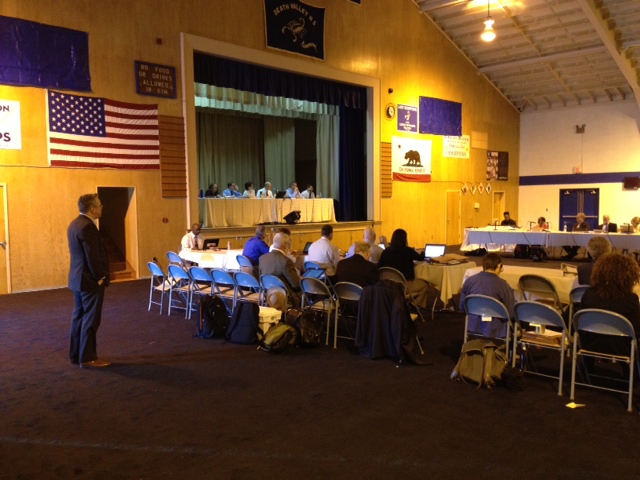
March 15, 2013 - Shoshone, CA. Basin and Range Watch members attended the evidentiary hearing which started March 11 in the small remote town in eastern Inyo County. About 80 people converged on this community of population 10 which serves as a tourist destination next to Death Valley National Park. California Energy Commission (CEC) staff and part of the committee which will decide whether to license arrived at the town, as well as the applicant BrightSource Energy, Inc., and several intervenors: Cindy MacDonald, a local resident of the area; Richard Arnold, member of the Southern Paiute Tribe; Inyo County; Inyo Fire and Protection Services; John Zellhoefer, a local resident; Amargosa Conservancy; and Center for Biological Diversity.
The two Commissioners from CEC attending are Karen Douglas (Presiding Member) and David Hochschild (Associate Member). Hearing Officer Kenneth Celli is overseeing the hearing.
The California Energy Commission is the lead agency for licensing thermal power plants 50 megawatts and larger under the California Environmental Quality Act (CEQA). The CEC carries out an environmental analysis of the project including an analysis of alternatives and mitigation measures to minimize any significant adverse effect the project may have on the environment. See the CEC page for this project >>here.
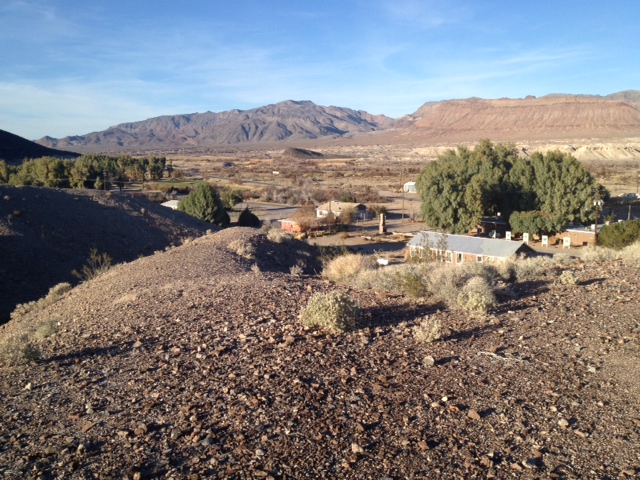
^Town of Shoshone.
Inyo County Settles
The morning started out with the intervenor County of Inyo announcing that all the concerns and issues it had with the applicant -- traffic problems, worker issues, road quality, etc. -- were dropped. The attorney for the county explained that the county board had voted this morning to make an agreement with BrightSource, and resolve all concerns. The agreement is public, and says BrightSource agreed to pay the county $15 million. The 15-page agreement says that BrightSource will pay Inyo $2.5 million upon commencement of construction and $12.5 million when the company starts to sell electricity. In exchange for this, Inyo County will not oppose the project when the California Energy Commission makes a decision on Hidden Hills.
Socioeconomics
The 5-square-mile project will be plopped right down in the midst of the rural community of Charleston View which lies in Inyo County, CA along the Nevada border. Energy Commission proceedings such as these were originally meant in part to allow neighbors of proposed power plants to voice their concerns and opposition. Unfortunately small towns and rural areas without a large population cannot compete with international companies which bring numerous lawyers and expert witnesses. Larger urban communities seem to have a better chance to oppose power plants in their neighborhoods by bringing large crowds to meetings. Rural communities are at a disadvantage.
In a society like ours which is dominated by the worship of numbers and quantitative analysis, reviews can become contorted and tangential. This is what occurred for the socioeconomic review of the Hidden Hills solar project. Hours were spent quibbling about census data that did not have a fine enough resolution to detect the percentage of people who lived below the poverty level (federally defined in 2012 at $23,050 total yearly income for a family of four). This was needed to determine whether this community would be considered under Environmental Justice review.
Some residents of Charleston Heights came forward to finally clarify that indeed, the majority of people living there earned less than $20,000 per year and often much less. Most people lived in old trailers, and were on Social Security and welfare. This was not an affluent community. Some residents objected to the power plant being placed so close to their properties.
Visual Resources
The CEC staff concluded that this area of Pahrump Valley where the project is located is of high scenic quality. The HHSEGS project will be located on approximately 3,277 acres (5.12 square miles) with two 750-foot tall power towers surrounded by thousands of mirrors. Staff concluded this would be a significant adverse impact, with no way to mitigate it.
CEC staff described how at 8 miles away there would be "significant brilliance and discomfort" to the eye. The "open character, panoramic vistas, and quality of life for residents" would be significantly impacted.
At night, 16 red lights would blink on each tower. Four lights every 200 feet along the tower would flash due to FAA regulations.
In addition, reflective glint from the thousands of heliostat mirrors would also cause flashes of light. The applicant claimed that these glints would only occur during transitory movement of the heliostats.
BrightSource agreed to use slatted chainlink fences to surround the project, although this would not prevent glint and glare from the project from being very visible from the nearby peaks of the Nopah and Kingston Mountain Wilderness Areas. A "visual interpretive facility" might be an agreeable mitigation according to the applicant.
BrightSource did not agree that impacts to the scenic vistas would be significant. Experts claimed scenic vistas were not necessarily in the legislative intent of a Wilderness Area. The boiler brightness is theoretical. The applicant asked staff to go view the power tower BrightSource operates at Coalinga, CA. Photos, they claimed, cannot reproduce this. The width of the boilers is similar. Arguments ensued about contradictory rules, how contrasted the background is with the light source, how the numbers are analyzed, distance, etc. The issue was not resolved between staff and the applicant.
Intervenor Richard Arnold, Southern Paiute, provided a differing perspective on the issue. He said cultural information cannot be compartmentalized like this. Vistas are integral to the Salt Song Trail. Glint and glare will impact ten different directions: north, south, east, west, up, down, past, present, future, and where you are. A project like this would impact everywhere equally in a cultural manner, one could not say if the impact is worse at a higher or lower point in the landscape, six inches away or 18 miles distant. To fully understand this, Mr. Arnold invited the committee to go out to the land on a field trip.
Intervenor John Zellhoefer questioned whether anyone even visited these nearby Wilderness Areas, how many people go there in a year? Staff said the Bureau of Land Management did not keep visitation records. We would argue that the definition of wilderness is the escape from crowds of people.
Basin and Range Watch provided an expert witness for intervenor Cindy MacDonald on how the Visual Impacts of the project would be significant and not mitigable. Wilderness Areas nearby would have their scenic vistas negatively impacted by such tall towers. Tourists from Death Valley National Park often chose the Old Spanish Trail route to travel to Las Vegas in order to find a scenic and open route with a character of the remote desert that many people seek in their visits. BrightSource lawyers cut the witness off before full testimony was given.
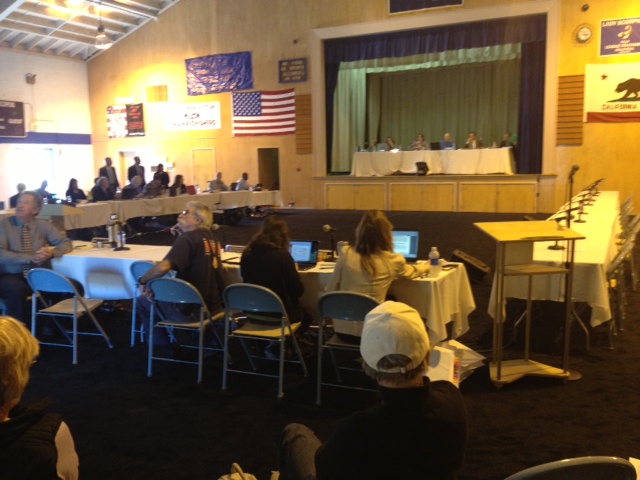
Water Resources
After much of the day arguing groundwater hydrology models, nothing was resolved. Little research has actually been done measuring the groundwater and its flow regionally, so competing models could not be meshed. The applicant continued to argue that their wells would not draw down water much, and staff continued to say the water pumping associated with the project could negatively impact the water levels at Stump Springs, the Amargosa River drainage, and local wells.
See the very good comment letter by California and Nevada offices of Bureau of Land Management, dated March 12, 2013, on the water-related concerns of the agency>>here (470 kb PDF).
Biological Resources
Rare plants
According to staff, 11 rare plants have been found on the project area, 4 requiring mitigation that will bring the impacts to less than significant.
Desert tortoise
Surveyors found two tortoises in 2011 on the project site, and 6 in the 150 m buffer zone. 58 burrows were found on the project site. The estimated number of adult tortoises that could actually be on the site is in the range of 6 - 33 (according to the applicant's witness) and 9 - 67 (according to staff).
Also in dispute was the quality of tortoise habitat on site. Dr. Alice Karl, expert for the applicant suggested that the habitat on the project site was mostly low, based on (we think an arbitrary) line drawn around the densest burrow concentrations on the eastern edge of the site. They wanted a compensatory land acquisition mitigation ratio of 0.5:1 for disturbed habitat, 1:1 for saltbush scrub habitat, and 1.5:1 for creosote bush habitat. This effectively would equal a 1:1 mitigation ratio overall.
Staff argued for higher mitigation ratios of 0:1, 1:1, and 3:1 respectively, for an effective ratio of 2:1. What this means is BrightSource would have to buy private land parcels somewhere in desert tortoise habitat that would equal two times the amount of habitat destroyed on the project site. This has proven to be tricky, and in practice often does not mean tortoise habitat nearby will be preserved. For the BrightSource solar project in Ivanpah Valley, which is in the eastern Mojave Desert of California, compensatory land was acquired in the West Mojave of California, hundreds of miles away in a different genetic population of tortoises. The land acquired was small scattered parcels. This is not a great win for the tortoise regardless of how much land is agreed upon.
The California Department of Fish and Wildlife (formerly Fish and Game) recommended a mitigation ratio of 3:1 across the site without parsing out separate habitat units. Vegetation overlays are a faulty correlation with tortoise populations, and are not used by the agency in determining mitigation ratios. Intervenor Center for Biological Diversity requested a mitigation ratio of 5:1.
There are 77 acres of disturbed land, 1,588 acres of saltbush scrub, and 1,668 acres of creosote bush scrub. We will note that tortoises will use shadscale saltbush scrub just as much as creosote bush scrub in our observations, and so lowering the mitigation ratio for this vegetation type is unjustified.
Burrowing owl
BrightSource argued that burrowing owls are common in the desert, and few were found on the project site. So no special measures were needed.
CEC staff disagreed, saying the burrowing owl is a species in decline, and several owls were seen on the project site, along with several burrows. An owl was seen as recently as January on a site visit. They recommended mitigation developed by the California Department of Fish and Wildlife to replace lost territories.
Solar Flux
The heat energy from concentrated sunlight reflected off the mirrors converging at the top of the tower will create a risk for flying birds. CEC staff modeled the impacts to bird feathers on a dark-colored bird theoretically flying at a certain speed through the flux field that will form around the solar receiver during the day when the power plant is generating electricity. This was a very contentious topic, and BrightSource disagreed with most of the modeling.
Bird feathers are made of keratin, which are made of protein molecules. At 160 degrees Celsius the proteins begin to break down and this adverse effect begins to damage the feather. As a bird flies through the flux field, exposures at 5 kilowatts per square meter of radiant flux will cause irreversible damage to feathers. See the chart below, this is an extensive area.
Staff contends Golden eagles and other birds will be killed by exposure to this flux field. The killing of even one protected species would be a significant impact.
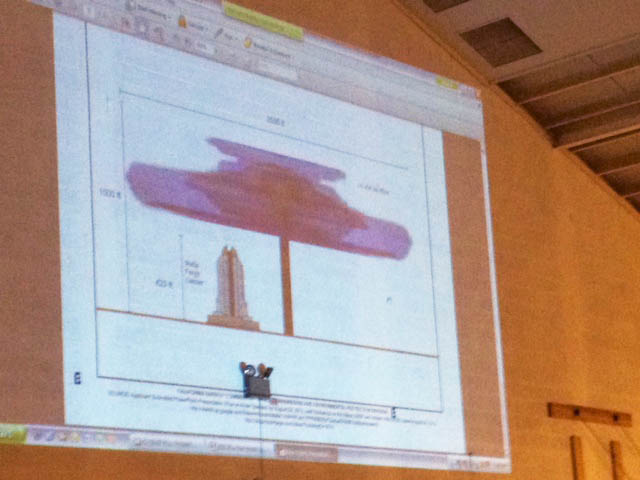
^Slide projected in the gymnasium during the hearing, showing the flux field on the solar power tower as modeled by the California Energy Commission. To the left of the 750-foot tower is the tallest building in Sacramento, at 423 feet. The light blue indicates the flux at 10 kilowatts per square meter, the middle darker blue indicates the 50 kW/m2, and the inner darkest blue right next to the receiver is at 500 kW/m2. The radius of the light blue flux is 2,000 feet out from the tower. The flux field at 10 kW/m2 starts around 500 feet up and goes upwards of 1,000 feet in the air. This will create a hot air thermal as well, rising above that could attract Golden eagles and other raptors which seek out such thermals for increasing flight height.
Golden eagles and Migratory birds
^Golden eagle in Pahrump Valley seen by Basin and Range Watch on February 23, 2013, about 4 miles from the Hidden Hills SEGS project site.
The applicant and CEC staff were in dispute over a number of issues, such as whether the project area was in a migratory corridor for birds, and whether eagles were common.
Staff argued the area was in a migratory corridor that included the Amargosa Valley, Ash Meadows, and Oasis Valley, and so birds might be numerous and diverse at certain seasons and suffer mortality from collision with mirrors and burning from solar flux from the towers. At Ash Meadows for instance, tens of thousands of Wilson's warblers have been counted migrating through annually. The CEC analysis concluded that 2,900-3,400 birds per year may collide with the heliostats.
BrightSource disputed these numbers, saying the area was not in a migratory corridor, and studies at other solar power towers showed no bird collisions with mirrors: the Gemasolar project in Spain, and BrightSource's own SEDC (Solar Energy Development Center) in Israel. The dismantled Solar 1 in Daggett, CA, had bird mortality associated with collisions and flux burning, but BrightSource said these projects were different and were in locations not conducive to bird deaths. Daggett should not be taken as the sole representative of a power tower. They argued the larger solar field at Hidden Hills would create less edge effects than the smaller Daggett project produced; birds would not venture as far into a massive solar field.
The Energy Commission biologists said Golden eagles were seen many times in the area, including on 5 separate days incidentally during tortoise surveys in April-May 2011. Golden eagle nests were found as close as 4.5 miles from the project site in the Nopah Range and Kingston Range.
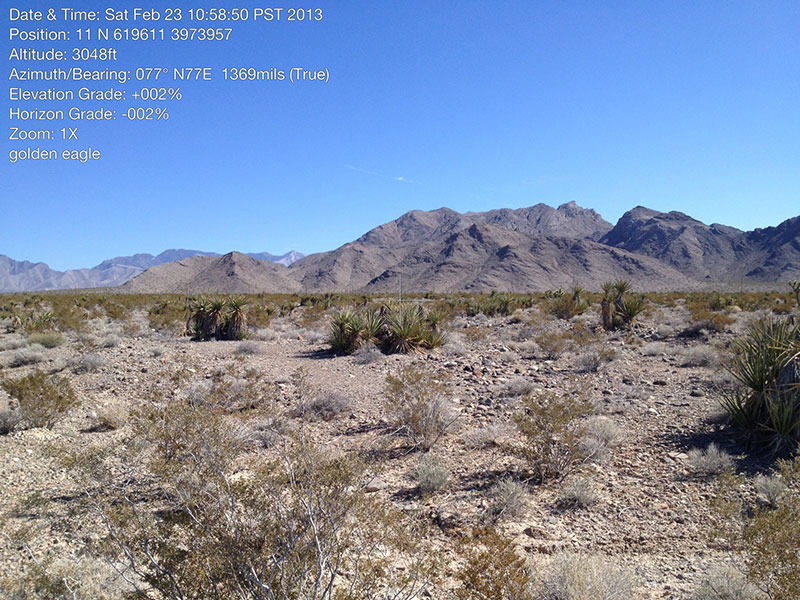
^Location and ground habitat in the Pahrump Valley of our Golden eagle sighting in February, showing the view looking in the direction the eagle was flying towards the northeast.
The risk of eagle death from solar flux is real, according to CEC. An Eagle Conservation Plan was needed. BrightSource indicated they did not consider and Eagle Conservation Plan needed. "We believe there will be no Take."
“Take” is clearly defined under the Bald and Golden Eagle Protection Act (BGEPA). If an eagle dies in the flux or as a result of heliostat collision, BrightSource will be in violation of the BGEPA if they are not required to obtain a Take permit from the US Fish and Wildlife Service before the project is approves and allowed to operate at the current risk factors being discussed. Any eagle kills by the Hidden Hills Project would be a Take.
The Bald and Golden Eagle Protection Act “provides for the protection of the bald eagle and the golden eagle (as amended in 1962) by prohibiting the take, possession, sale, purchase, barter, offer to sell, purchase or barter, transport, export or import, of any bald or golden eagle, alive or dead, including any part, nest, or egg, unless allowed by permit(16 U.S.C. 668(a); 50 CFR 22). "Take" includes pursue, shoot, shoot at, poison, wound, kill, capture, trap, collect, molest or disturb (16 U.S.C. 668c; 50 CFR 22.3). The 1972 amendments increased civil penalties for violating provisions of the Act to a maximum fine of $5,000 or one year imprisonment with $10,000 or not more than two years in prison for a second conviction. Felony convictions carry a maximum fine of $250,000 or two years of imprisonment. The fine doubles for an organization. Rewards are provided for information leading to arrest and conviction for violation of the Act.”
Due to the amount of unknown information regarding the scale of this project and avian mortality, we believe that the proceedings need to be slowed down until the applicant can resolve the issues of a Take permit under the Bald and Golden Eagle Protection Act.
While we realize that it is not the responsibility of the CEC to enforce the Bald and Golden Eagle Protection Act, it appears that it could be a violation of Federal law to allow this project to proceed without resolving the issues of Take for golden eagles. The CEC should make a decision that is consistent with the Federal laws.
Under California state law no Take (killing) of golden eagle is allowed without a Natural Community Conservation Plan. There is no such plan for the Hidden Hills desert area.
We would like to request that the California Energy Commission suspend the proceedings of the Hidden Hills solar project until these avian issues can be resolved. The applicant should agree to apply for a Take permit under the Bald and Golden Eagle Protection Act.
We would also like to request that the approval process for Hidden Hills be delayed until more data can be gathered on the other BrightSource project that has been under construction for the past 2 and a half years, the Ivanpah SEGS Project. As interveners on the Ivanpah Project, we helped bring the flux issue to the attention of the California Energy Commission, but the full extent of how serious it is seemed to be difficult to initially communicate to the CEC. Unit 1 of the Ivanpah is scheduled to go into operation later this year. A two to three year study on flux mortality should be initiated and no more power towers should be approved until we can obtain some solid data on mortality numbers for flux and mirror collision.
The rush of renewable energy is now killing golden eagles, primarily due to wind energy projects. So far there are unresolved legal issues with two of these wind energy projects. One is the North Sky River Project in California, the other is a recent kill at the Spring Valley Wind Project located in northern Nevada. Both of these projects had streamlined permitting processes and neither was required to prepare enough mitigation measures for potential eagle kills. Both intentionally avoided getting Take permits under the Bald and Golden Eagle Protection Act. North Sky is already under litigation and the Spring Valley Golden eagle kill occurred in February 2013.
BrightSource offered to mitigate bird collisions by paying for retrofitting existing transmission lines (which eagles may collide with), and do a 1:1 compensatory land acquisition to offset eagle foraging habitat that will be removed. BrightSource claimed in their own analysis showed there would be no Take of eagles at the project. They pointed out US Fish and Wildlife Service has not yet developed guidelines for eagles and solar plants. BrightSource said before they made an Eagle Conservation Plan, these solar guidelines should be developed first.
Staff, however, said land acquisition is already included as nested in other land acquisition for tortoises and other species. Staff also said existing the best methods to minimize flux impacts could be used, some language added, and a set of criteria added to the conditions for certification.
Center for Biological Diversity said that eagles have been seen foraging on the project site, and habitat will be removed. So the applicant should be required to get a Take permit under the Bald and Golden Eagle Protection Act. If wind and solar projects continue to kill eagles and remove habitat, the Golden eagle may need to be protected under the Endangered Species Act in the future.
At this point, we believe the only way for the project to proceed is for the CEC committee hearing the case to "over-ride" the significant impact of eagle Take from solar flux and mirror collision under the California Environmental Quality Act (CEQA). Then the project could be approved. But we question this method of simply going around environmental laws.
Bighorn sheep
All parties acknowledged that Desert bighorn sheep move through the area and the project may disrupt those movements. No other discussion occurred.
Desert kit fox
Based on recent deaths of kit foxes at other large-scale solar construction sites, the potential for displacement mortality of the foxes was brought up. Center for Biological Diversity had recently petitioned the desert kit fox for listing under the federal Endangered Species Act. They pointed out that the recent Record of Decision by Bureau of Land Management for the McCoy Solar Energy Project included much more rigorous and comprehensive language for passive relocation of kit foxes than that recommended by staff on this project. A baseline census needs to be done, health issues addressed (canine distemper has broken out on the Genesis Solar Energy Project in Riverside County), and subsequent monitoring of kit fixes was required.
Biological soil crusts
Center also brought up the issue of cryptobiotic soils that uptake CO2. They brought up how no one has gone on the site to actually measure the extent of living soil crusts on the project site. They wanted to see a life cycle analysis of the project and CO2 offset compared to CO2 disruption as the soil is disturbed. No quantification has been done, only guesses and inferences by staff.
The CEC admitted there is an increased concern over the loss of biological soil crust which have so many ecosystem services: fixing CO2 and atmospheric Nitrogen, mitigation of global warming, facilitating seedling germination, slowing soil runoff, and controlling dust. This is an evolving science, especially when the question of how much CO2 is released when soil crusts are disturbed. Alkaline soils also store carbon. But despite this, staff in our opinion summarily dismissed biological soil crusts as not common on the site and therefore not significant, even though they did not go out and measure it.
Groundwater-dependent vegetation
The Honey mesquite areas could be impacted by groundwater pumping, although staff and the applicant came to an agreement on how to mitigate this with a monitoring plan. A "stop pumping trigger" of groundwater drawdown was taken out, and in its place a decreasing of pumping trigger. If groundwater levels are detected to be lowering, the applicant will slow pumping so that groundwater levels are restored to previous levels.
The Pahrump Basin is already overdrawn and any further lowering of water levels will cause negative impacts.
Cultural Resources
There seems to be absolutely no way to mitigate the impacts this project will have on cultural resources. BrightSource has agreed to placing interpretive kiosks in the area, and not much more.
Members of the Old Spanish Trail Association (OSTA), a national organization that seeks to research the route of this historic trail, describe it, and preserve it. BrightSource contended that the actual trail did not go through the project, while OSTA presented detailed evidence that spurs of the trail did indeed cross the project site and therefore history would be lost. OSTA sought mitigation in the form of a museum, a traveling van that interprets the trail history, and a full-length video with re-enactments of historical time periods.
Richard Arnold (Southern Paiute), the first Native American intervenor in a large-scale solar project reviewed by the CEC, spoke at length on the importance of the Salt Song Trail. This sacred landscape crosses extensive networks of desert and mountain across California, Nevada, Utah, and Arizona.
The Salt Songs are the sacred songs of the Nuwuvi and are used at memorial and other ceremonies, for cultural revitalization and as a spiritual bond for the Southern Paiute people living in the Southwest. The songs describe a physical and spiritual landscape of the Colorado Plateau, painted deserts and river valleys, and the Salt Song Trail traces the journeys of ancestral peoples to historic, spiritual and sacred sites. Tribal members gather to sing hundreds of songs through the night at funerals. Formerly the songs lasted four days and four nights, and each song is specific to a certain place: Mt. Charleston -- the center of creation, Pahrump Valley, California Valley, Emigrant Pass, the Providence Mountains, etc.
Part of the Salt Song Trail passes through the Hidden Hills area, according to Arnold. These songs are place-based, the songs echo between the singers, the land, and the spirits of the departed as the singers help the departed along on their journey. He explained how the singers must imagine, visualize the landscape as they sing it, and visit the land in spirit. Sometimes the singers have to go to the landscape physically.
One area of the Salt Song is the Hidden Hills area, but many areas were redacted from maps so as to protect the culturally sensitive locations.
The singers have to think about the grieving families, Arnold said. But the Pauite do not have a word for "mirrors" or "solar flux." But now it will have to be included in the songs if it becomes part of the landscape.
Matthew Leivas, Sr. (Chemehuevi) co-founder and co-director of the Salt Song Trail Project with the Cultural Conservancy, had a vision to preserve and revitalize the Salt Songs (Asi Huviav Puruakain) of the Southern Paiute (Nuwuvi) people. He gave testimony to the CEC about the history of his people trying to preserve their culture in the face of loss from Euro-American acculturation.
The Salt Song Singers have worked closely with the Cultural Conservancy out of San Francisco to make a video explaining the importance of this sacred landscape. Members of Basin and Range Watch have been in contact with the Cultural Conservancy and can attest to the vital work of making known these cultural treasures. The Salt Song Trail is a nationally and globally important legacy and should be given great consideration in this case.
Worker Safety and Fire Protection
The project site is in a remote part of Inyo County. Southern Inyo Fire Protection District on March 18 requested $400,000 annually from the applicant to be able to serve the area with fire and emergency response. The nearest station that could provide such as 80 minutes away.
The Pahrump Fire Department is closer but is in Nevada, not California. So they do not have jurisdiction.
